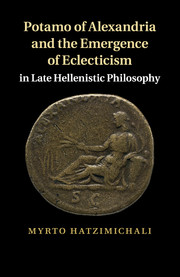Book contents
- Frontmatter
- Contents
- Acknowledgements
- Abbreviations
- Introduction
- Chapter 1 Eclecticism in modern and ancient thought
- Chapter 2 Eclecticism and Alexandria in the first century bc
- Chapter 3 Potamo of Alexandria, life and work
- Chapter 4 The eclectic system of Potamo's Elementary Teaching
- Chapter 5 Potamo and Aristotle's On the Heavens
- Chapter 6 Further references to Potamo
- Chapter 7 Conclusions
- Bibliography
- General index
- Index of passages cited
Chapter 4 - The eclectic system of Potamo's Elementary Teaching
Published online by Cambridge University Press: 05 July 2011
- Frontmatter
- Contents
- Acknowledgements
- Abbreviations
- Introduction
- Chapter 1 Eclecticism in modern and ancient thought
- Chapter 2 Eclecticism and Alexandria in the first century bc
- Chapter 3 Potamo of Alexandria, life and work
- Chapter 4 The eclectic system of Potamo's Elementary Teaching
- Chapter 5 Potamo and Aristotle's On the Heavens
- Chapter 6 Further references to Potamo
- Chapter 7 Conclusions
- Bibliography
- General index
- Index of passages cited
Summary
Diogenes Laertius offers a very brief overview of Potamo's doctrines, based on the traditional division of philosophy into logic (where epistemology played a central role), physics and ethics (compare D.L. 7.39–41, with reference to the Stoics). Within this scheme, the short report concentrates on Potamo's responses to the central issues on which one needed to articulate a position in order to declare allegiance to a particular school or venture a claim of doctrinal originality: the criterion of truth (epistemology); the first principles (physics); and the moral end (ethics). The few lines from Diogenes have to provide the bulk of our evidence for an assessment of Potamo's eclecticism and the type of approach to preceding philosophical traditions that this (self-) characterisation implies.
Recalling the programmatic report that Potamo ‘selected the doctrines (i.e. his doctrines) from each of the sects’, important questions that will come under consideration include (i) Which sects are understood in the rather vague expression ‘each of the sects’? (ii) Does Potamo select ideas from each of these equally, or is he influenced by some more than by others? (iii) Should we imagine his Stoicheiosis as an anthology of ‘approved’ (ἀρέσαντα) doctrines simply listed side by side, or as an attempt to make something out of the selected ideas by drawing connections and correlations? The information that Potamo was not simply a historian of philosophy but had introduced his own sect, which would require a programmatically distinct intellectual attitude of some sort, already points towards the latter option.
- Type
- Chapter
- Information
- Publisher: Cambridge University PressPrint publication year: 2011

